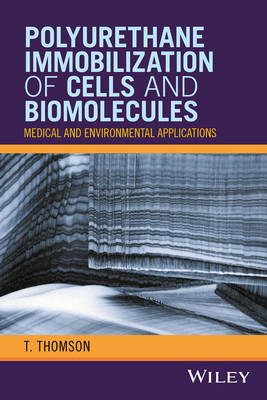
Polyurethane Immobilization of Cells and Biomolecules
John Wiley & Sons Inc (Verlag)
978-1-119-25469-0 (ISBN)
• Offers an essential resource for medical and environmental scientists
• Provides a multidisciplinary and lucid writing style that uses little or no jargon
• Extrapolates current technology into advanced areas, especially environmental remediation and medical devices
• Fills the gap between immobilization research and practical applications
T. THOMSON, MS, is Director of Main Street Technologies. He was the founder and Chief Technical Officer of Hydrophilix, Inc., a technology-based firm specializing in the development of advanced medical devices, environmental remediation technologies and consumer products. Mr. Thomson is known for his expertise in the development of products based on hydrophilic polyurethane (HPUR), and his current research includes the application of polyurethane composites to developing scaffolds for cell growth. He wrote 3 books on the subject, holds 7 patents in synthetic chemistry and process control, and has sponsored several seminars on the medical applications of specialty polyurethanes.
Preface ix
1 Polyurethane Chemistry 1
Introduction 1
The Chemistry 2
The Isocyanates 3
The Polyol 5
Cross-Linking 5
The Water Reaction 6
Process 8
The One-Shot Process 8
The Prepolymer Process 10
Post Processing 12
Architecture of Polyurethane Foam 14
Grafting to the Polyurethane Foam 16
Biodegradable PUR 19
Mechanism of Biodegradation 23
More Examples 24
Conclusion 25
References 26
2 Laboratory Practice 29
Introduction 29
Prepolymers 30
Preparation of an Elastomer 30
Preparation of Foam 32
Hydrophobic Foams 32
Hydrophilic Foams 34
Custom Prepolymers, Foams, and Scaffolds 40
Examples 43
Structure–Property Relationships 48
The Special Case of Hydrophilic Polyurethane Foams 50
Physical and Chemical Testing 50
Physical Testing 52
Biocompatibility Testing 54
Process Equipment 54
Metering Pump 55
Mixing Head 55
Tank/Material Retaining Container 55
Machine Manufacturers 56
References 56
3 Scaffolds 59
Introduction 59
Bioscaffolds 61
Examples of Biofilter 65
Elimination of Tobacco Odor from a Cigarette-Manufacturing Plant 67
Treatment of VOCs from an Industrial Plant 68
The Liver as Biofilter 68
Scaffolds for Medical Applications (In Vivo and Extracorporeal) 70
The Liver Model 71
The Extracellular Matrix as Scaffold 72
The Physical Scaffold 73
Design of an Ideal Scaffold 74
Drug Discovery 75
Materials of Construction 77
Ceramics 77
Metals 80
Polymer Scaffolds 82
Poly(lactic Acid) 82
Poly(glycolic Acid) 82
Polycaprolactone 83
Polyurethanes 83
The “Ideal” Scaffold 87
Pore Size and Distribution 89
Void Volume 91
Interconnectedness 96
Surface Area 98
Mechanical Properties 100
Surface Chemistry 100
Specifications
of the Ideal Scaffold 101
References 105
4 Immobilization 109
Introduction 109
Methods of Immobilization 111
Immobilization by Adsorption 113
Biofiltration 113
Biotrickling Filter Setup and Operating Conditions 115
The Toluene Reactor 116
The H2S Reactor 120
Biological Treatment of Aquarium Tanks 123
Protein Adsorption 125
The Avidin–Biotin System 126
Application of the Avidin–Biotin System to Cell Adhesion to a Scaffold 128
Adsorption to a Tricalcium Phosphate (TCP) Scaffold Using the Avidin–Biotin System 128
Hepatic Cells on a Fabricated Polycaprolactone Scaffold 131
Summary of Immobilization by Adsorption 132
Immobilization by Extraction 133
Extraction of Pesticides 138
Summary 144
Immobilization by Entrapment 145
Alginate Encapsulation 146
Encapsulation of Pancreatic Islet Cells 148
Encapsulation of Osteoblasts 148
Introduction to the Pancreas Model 149
The Pancreas Model 150
Summary of Encapsulation 154
Immobilization by Covalent Bonding 154
Overview of Covalent Immobilization 156
Substrates Used for Immobilization 157
Alginates 158
Albumin 159
Collagen 159
Synthetic Polymers as Supports 159
Polyethylene 159
Poly l-Lactic Acid 160
Immobilization to Polyvinyl Chloride 161
Ceramics 163
Summary 163
Polyurethane Immobilization 164
Fundamental Principles 164
Prepolymer Chemistry 168
The Immobilization Chemistry 169
Structure and Chemistry of Biomolecules 170
Preparation of Immobilized Biomolecules 171
Notable Uses of Polyurethane for Immobilization 174
Organophosphates 174
Lipases 177
Fibroblasts 178
Collagen 180
Amyloglucosidase 182
Novel Reactor System 184
Endothelialization 185
Creatinine 186
Conclusion to Immobilization 187
References 189
5 Controlled Release from a Hydrogel Scaffold 195
Introduction 195
Release Rates 198
Examples of Hydrogels Used for Controlled Release 198
Polysaccharides 199
Pectin 199
Alginates 200
Carrageenan 200
Agar 200
Starch 200
Proteins 200
Gelatin 200
Casein 201
Other Proteins 201
Controlled
Release by Diffusion 201
Reservoir Layer 202
Diffusion Experiments 206
Islet Encapsulation 208
Other Controlled Release Examples 211
Targeted Delivery 211
Stomach 212
Small Intestines 212
Colon 212
Summary and Conclusions 213
References 213
Index 215
| Erscheinungsdatum | 16.04.2018 |
|---|---|
| Verlagsort | New York |
| Sprache | englisch |
| Maße | 155 x 231 mm |
| Gewicht | 522 g |
| Themenwelt | Medizin / Pharmazie ► Physiotherapie / Ergotherapie ► Orthopädie |
| Naturwissenschaften ► Biologie | |
| Naturwissenschaften ► Chemie | |
| Technik ► Maschinenbau | |
| Technik ► Medizintechnik | |
| Technik ► Umwelttechnik / Biotechnologie | |
| ISBN-10 | 1-119-25469-8 / 1119254698 |
| ISBN-13 | 978-1-119-25469-0 / 9781119254690 |
| Zustand | Neuware |
| Informationen gemäß Produktsicherheitsverordnung (GPSR) | |
| Haben Sie eine Frage zum Produkt? |
aus dem Bereich


